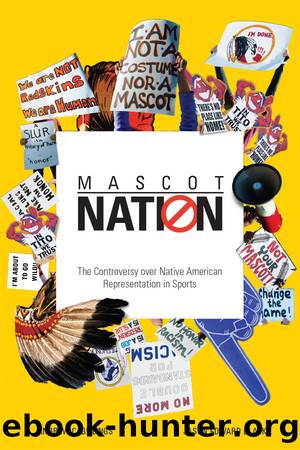Mascot Nation by Andrew C. Billings Jason Edward Black

Author:Andrew C. Billings, Jason Edward Black [Andrew C. Billings, Jason Edward Black]
Language: eng
Format: epub
ISBN: 9780252050848
Barnesnoble:
Publisher: University of Illinois Press
Published: 2018-10-08T00:00:00+00:00
Figure 5.15. The current Chief Wahoo.
While some teams, even the Washington R-dskins, work into their Native American logos Native faces that resemble people, even when the imagery, such as a feather or bonnet or war paint, can appear somewhat trite and reductive, Wahoo is different. He could easily fit in comfortably with a Peanuts character in the Sunday comics section of any given newspaper. Some have argued that he fails to echo any sense of human beingness at all. Perhaps this is at least partly why some question Wahoo as âan unambiguous racial icon meant to symbolize stereotypical and usually negative images of Native people as âwildâ but âfriendlyâ savages.â45 His mysteries as a caricature call for attention and beg questions of both authenticity and the potential for harm by way of his cartoonishness itself. Staurowsky frets that the âfacially shallow imagery of American Indians that resides in the recesses of the American subconscious exempts the populace from accountability for genocide.â46 Whereas one might possibly read across Chief Osceola's sun-battered face, marked with wrinkles of worry and resolve, the reality of removal or terminationâas a visual enthymemeâthere is no such realism confirmed in a caricatured mascot face. Instead, the smiling Indian obviates the austerity of Native American experiences.
To the question of whether Wahoo represents a bellicose âIndianâ ready to take the playing field as a surrogate for the battlefield, one might read fansâ actuation of the logo as an affirmative sign. The image in figure 5.16 approximates a muscular image of Wahoo, with added arms and torso, literally busting out of his shirt. A number of placards include textual descriptors about his warrior-like behavior. In one image from the 2014â2016 era, the Wahoo placard states simply yet tellingly, âScalp N.Y.â47 There remains little pondering about how the fan views Wahoo's character. He is clearly violent, stereotypically so, as Native Americans are often homogenized as immemorially taking scalps from their opponents. Nativesâ so-called brutishness was apparently a powerful inventional resource for the Cleveland franchise. Journalist David Leonhardt reports, âThe ugliness of the logo is no accident. When Cleveland chose the name in 1915, it had the worst stereotypes in mind: âIndians on the warpath all the time. And eager for scalps to dangle at their belts,â according to a 1915 newspaper article.â48 Such imagery connects with the âsavage Indianâ stereotype discussed in chapters 1 and 2. The other image reads, âI'm about to go wild!â as if Wahoo's bestial ethos is poised to be on the loose.49 In slangish parlance, Wahoo is on the cusp of being âoff the reservation,â an analog for roguely breaking with normative comportment and turning instead to vileness or insane behavior.
Download
This site does not store any files on its server. We only index and link to content provided by other sites. Please contact the content providers to delete copyright contents if any and email us, we'll remove relevant links or contents immediately.
The Inner Game of Tennis by W. Timothy Gallwey(3543)
Unstoppable by Maria Sharapova(3442)
Urban Outlaw by Magnus Walker(3310)
Crazy Is My Superpower by A.J. Mendez Brooks(3277)
Mind Fuck by Manna Francis(3071)
The Social Psychology of Inequality by Unknown(2907)
The Fight by Norman Mailer(2808)
Unstoppable: My Life So Far by Maria Sharapova(2423)
Accepted by Pat Patterson(2272)
Going Long by Editors of Runner's World(2257)
Futebol by Alex Bellos(2195)
The Happy Runner by David Roche(2171)
Backpacker the Complete Guide to Backpacking by Backpacker Magazine(2155)
Motorcycle Man by Kristen Ashley(2147)
The Sports Gene: Inside the Science of Extraordinary Athletic Performance by David Epstein(2092)
Sea Survival Handbook by Keith Colwell(2086)
Peak: Secrets from the New Science of Expertise by Anders Ericsson & Robert Pool(1960)
Endure by Alex Hutchinson(1905)
The Call of Everest by Conrad Anker(1843)
